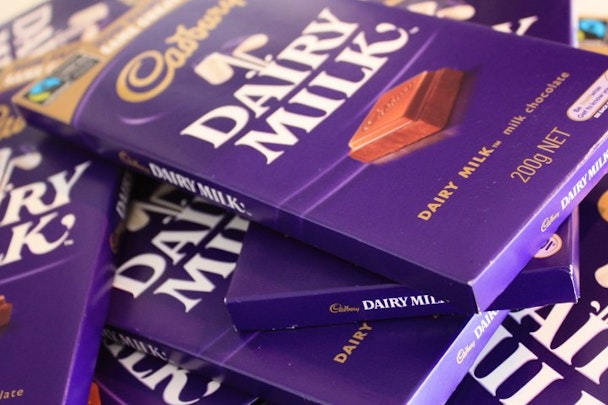Cadbury purple trademark battle isn't over yet
Cadbury has faced yet another setback over its decades-long battle to own the right to trademark the colour purple, which it has used for its chocolate bars since 1905.

Cadbury lose in the court of appeal
A decision by the UK Court of Appeal in 2013 to reject its second trademark placed Cadbury's valid 1995 trademark, which only covers chocolate in the form of bars, in murky waters. The Court of Appeal's decision today (5 December) denies Cadbury the right to change the description of its original trademark, weakening its claim to the colour.
As a colour, purple is hardly a shrinking violet. A time-old rock star favourite, we’ve had Purple Haze, Purple Rain and even Deep Purple. It also takes centre stage of Alice Walker’s award-winning book, ‘The Color Purple.’ And it doesn’t stop at cultural references.
Cadbury is not even the first chocolate brand to gravitate towards its evocative hue. Other brands include Milka and Nestle.
The decision concerns Pantone 2685C, which Cadbury has claimed rights to since 1995.
The chocolate brand's original 1995 application had the following description: “The mark consists of the colour purple (Pantone 2685C) as shown on the form of the application, applied to the whole visible surface, or being the predominant colour applied to the whole visible surface, of the packaging of the goods.”
The trademark is only registered for “chocolate in bar or tablet form,” so in 2004, Cadbury applied for a new trademark, so it could venture further afield into the realms of cake, chocolate more generally and drinking chocolate.
However, due to opposition from Nestle, its main chocolate competitor, Cadbury failed to monopolise legally on broadening the trademark for its range of purple-covered chocolate products.
Nestle opposed the trademark, claiming that the shade of purple had no distinctive character, and was too broad for a range of goods.
As a result of Nestle’s opposition, the UK Court of Appeal rejected the trademark application in October 2013, because it felt that the description did not adequately define the mark.
The decision was primarily because of the wording: "being the predominant colour applied to the whole visible surface, of the packaging of the goods." The court found that the term 'predominant' was too broad.
After the decision was made, Cadbury quickly realised that it meant its existing 1995 UK registration was potentially invalidly registered, because it used the same description as the 2004 application.
In an attempt to overcome this potential pitfall, Cadbury returned to court claiming that the existing UK registration was actually for a series of two different marks: 1) the colour purple (Pantone 2685C) applied to the whole visible surface of the packaging of the goods, and 2) the colour purple (Pantone 2685C) being the predominant colour applied to the whole visible surface of the packing of the goods.
It, therefore, appealed to alter the registered trademark, to remove the second mark which renders it invalidly registered.
The principal route is to treat the registration as a "series" of trademarks registered pursuant to section 41 of the Trade Marks Act 1994.
The decision today does not accept Cadbury's argument that there are two marks in the 1995 trademark registration. The case argues that the registrar has allowed registration not of a series consisting of two marks, but a series consisting of an unknown number of marks — a generalised but imprecise description of a single mark.
The loss in the court of appeal leads the way for rivals to start using the colour for their own chocolates, or for knock-off brands to pass off their products as Cadbury's, as although it still technically has a valid trademark, the use of the word 'predominant' places it in a precarious situation.
Colour protection wars are a reality not only in the chocolate manufacture realm. In 2013, Yves Saint Laurent succumbed defeat from Christian Louboutin and it’s trademark red sole when a judge ruled that no other shoe brand could sell shoes with red soles, unless the shoe itself is red.
Back in 2004, the mobile network operator Orange got overprotective of its fruity brand colour. Concerned that the airline company easyJet's use of Pantone 021C was a little too close to its trademark 151C, the phone brand kicked up a fuss, to dispel the airline from its territory.
Rebecca Anderson-Smith, a trademark attorney at IP law firm Mewburn Ellis commented on the significant blow to Cadbury: "Although seemingly about an administrative point, this decision is a significant blow to Cadbury, as it means the wording ‘being the predominant colour applied to the whole visible surface’, previously considered too broad by the Court of Appeal, has to remain in their registration. This leaves the registration open to attack by Nestle and other third parties for being invalidly registered.
“Today’s decision from the Court of Appeal confirms previous decisions of the UK Intellectual Property Office and the High Court, and refuses to accept that Cadbury’s registration is for a series of two different marks.”
“The Court of Appeal has previously held that the wording ‘The mark consists of the colour purple, Pantone 2685C, being the predominant colour applied to the whole visible surface, of the packaging of the goods’ potentially opens the door to a multitude of different visual forms. Therefore, if the Court had accepted Cadbury’s argument that their UK registration is for a series of marks, Cadbury would arguably have a registration for a series containing an unknown number of different marks, consisting of the varying different forms. Unsurprisingly, this is something that the Court of Appeal was keen to prevent.”

